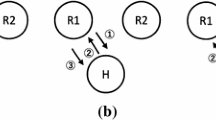Abstract
In a human-robot conversation, it is difficult for the robot to start the conversation just when the user is ready to listen to the robot, due to recognition technology issues. This paper proposes a novel approach to starting a conversation smoothly by using the cooperative behavior of two robots. In this approach, the two robots try to fill the blank time until the person is ready to listen by showing an interaction between the robots to attract the person’s attention. To evaluate the effectiveness of the approach, we conducted an experiment, which compared the following three methods of starting a conversation: early timing, late timing by one robot, and the proposed method. The results showed that participants almost ready to listen and not feel awkward when interacting with two robots with the proposed method, compared to one robot with early and late timing.
Access this chapter
Tax calculation will be finalised at checkout
Purchases are for personal use only
Similar content being viewed by others
References
Arimoto, T., et al.: Cooperative use of multiple robots for enhancing sense of conversation without voice recognition. SIG-SLUD B5(2), 76–77 (2015). (In Japanese)
Takahashi, T., et al.: A social media mediation robot to increase an opportunity of conversation for elderly: mediation experiments using single or multiple robots. In: Technical Committee on Cloud Network robotics (CNR), vol. 113, No. 84, pp. 31–36 (2013). (In Japanese)
Sakamoto, D., et al.: Humanoid robots as a broadcasting communication medium in open public spaces. Int. J. Social Robot. 1(2), 157–169 (2009)
Shiomi, M., et al.: Do synchronized multiple robots exert peer pressure? In: Proceedings of the Fourth International Conference on Human Agent Interaction, Biopolis, Singapore, pp. 27–33 (2016)
Iio, T., et al.: Pre-scheduled turn-taking between robots to make conversation coherent. In: Proceedings of the Fourth International Conference on Human Agent Interaction, Biopolis, Singapore, pp. 19–25 (2016)
Karatas, N., Yoshikawa, S., De Silva, P.R.S., Okada, M.: NAMIDA: multiparty conversation based driving agents in futuristic vehicle. In: Kurosu, M. (ed.) HCI 2015. LNCS, vol. 9171, pp. 198–207. Springer, Cham (2015). doi:10.1007/978-3-319-21006-3_20
Sinder, C.L., et al.: Where to look: a study of human-robot engagement. In: International Conference on Intelligent User Interfaces (IUI 2004), pp. 78–84 (2004)
Nakano, Y.I., et al.: Estimating user’s engagement from eye-gaze behaviors in human-agent conversations. In: International Conference on Intelligent UserINterfaces, pp. 139–148 (2010)
Yamazaki, K., et al.: Prior-to-request and request behaviors within elderly day care: implications for developing service robots for use in multiparty settings. In: Bannon, L.J., Wagner, I., Gutwin, C., Harper, R.H.R., Schmidt, K. (eds.) ECSCW 2007, pp. 61–78. Springer, London (2007). doi:10.1007/978-1-84800-031-5_4
Bergstrom, N., et al.: Modeling of natural human-robot encounters. In: IEEE/RSJ International Conference on Intelligent Robots and System (IROS 2008), pp. 2623–2629 (2008)
Kuzuoka, H., et al.: Re-configuring spatial formation arrangement by robot body orientation. In: ACM/IEEE International Conference on Human-Robot Interaction (HRI 2010), pp. 285–292 (2010)
Shi, C., et al.: Spatial formation model for initiating conversation. In: Conference on Robotics: Science and Systems (RSS 2011) (2011). doi:10.15607/RSS.2011.VII.039
Goodwin, C.: Restarts, pauses, and the achievement of a state of mutual gaze at turn beginning. Sociol. Inq. 50(3–4), 272–302 (1980)
Acknowledgments
This work was supported by JST ERATO Grant Number JPMJER1401, Japan.
Author information
Authors and Affiliations
Corresponding author
Editor information
Editors and Affiliations
Rights and permissions
Copyright information
© 2017 Springer International Publishing AG
About this paper
Cite this paper
Iio, T., Yoshikawa, Y., Ishiguro, H. (2017). Starting a Conversation by Multi-robot Cooperative Behavior. In: Kheddar, A., et al. Social Robotics. ICSR 2017. Lecture Notes in Computer Science(), vol 10652. Springer, Cham. https://doi.org/10.1007/978-3-319-70022-9_73
Download citation
DOI: https://doi.org/10.1007/978-3-319-70022-9_73
Published:
Publisher Name: Springer, Cham
Print ISBN: 978-3-319-70021-2
Online ISBN: 978-3-319-70022-9
eBook Packages: Computer ScienceComputer Science (R0)




